Abstract
To evaluate the effects of saline loading on distal sodium reabsorption in hypertensive man, studies were performed during both water deprivation and water diuresis in eight hypertensive subjects, and the results were compared to data obtained from similar studies in normal subjects. All hypertensive patients exhibited an enhanced excretion of filtered sodium (CNa/CIn) at any level of distal delivery of sodium compared to normal controls. Free water reabsorption (TcH2O) during hypertonic saline loading was quantitatively abnormal in the hypertensives at high levels of osmolar clearance (COsm), and also the curve of TcH2O vs. COsm leveled off above a COsm of 18 ml/min per 1.73 m2 in the hypertensive group in contrast to the normal controls in whom TcH2O showed no evidence of achieving an upper limit. Sodium depletion exaggerated the abnormality in TcH2O in hypertensives, and resulted in a positive free water clearance (CH2O) during hydropenia.
During hypotonic saline loading in water diuresis, changes in free water clearance per 100 ml of glomerular filtrate (CH2O/CIn) were less at any given increment in urine flow per 100 ml of glomerular filtrate (V/CIn) in the hypertensives compared to normal controls (P < 0.001). This abnormality in CH2O/CIn in the hypertensives in conjunction with the defect in TcH2O observed during hydropenia indicates that sodium reabsorption in the loop of Henle was abnormal at any given rate of distal delivery of sodium in hypertension. Furthermore, these abnormalities in TcH2O and CH2O coincided temporally with the development of the exaggerated natriuresis. Although the distal defect in sodium transport, in large part, accounted for the augmented natriuresis in hypertension, evidence was present also for enhanced rejection of sodium in the proximal tubule during saline loading in the hypertensives.
Additional studies utilizing acetazolamide which increases distal delivery of sodium without extracellular fluid volume expansion showed only minimal abnormalities in CH2O in the hypertensive group, indicating that the defect in sodium transport in the loop of Henle in hypertensives is mainly an abnormal response to extracellular fluid expansion rather than an intrinsic defect in the loop to handle increased tubular loads of sodium. It is possible that the abnormality in sodium reabsorption in the loop of Henle is due to the transmission of the abnormally elevated blood pressure of the hypertensives to the medullary vasa recta during saline loading.
Full text
PDF
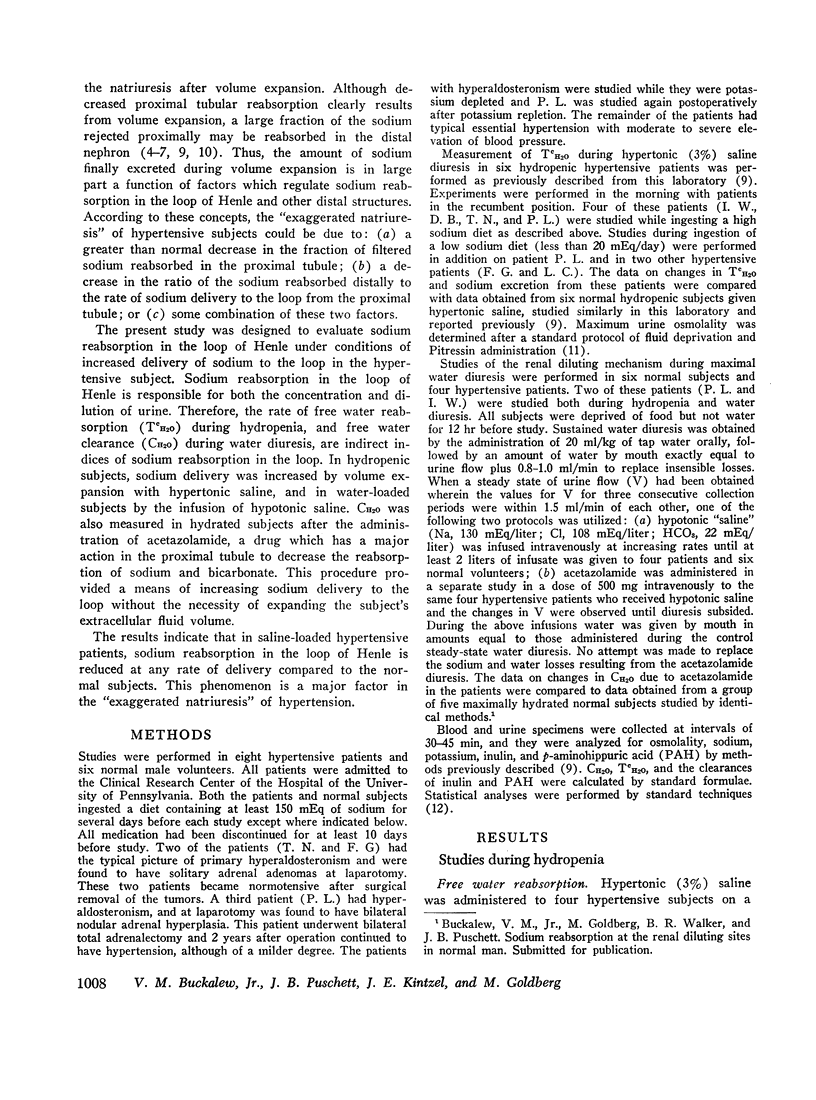
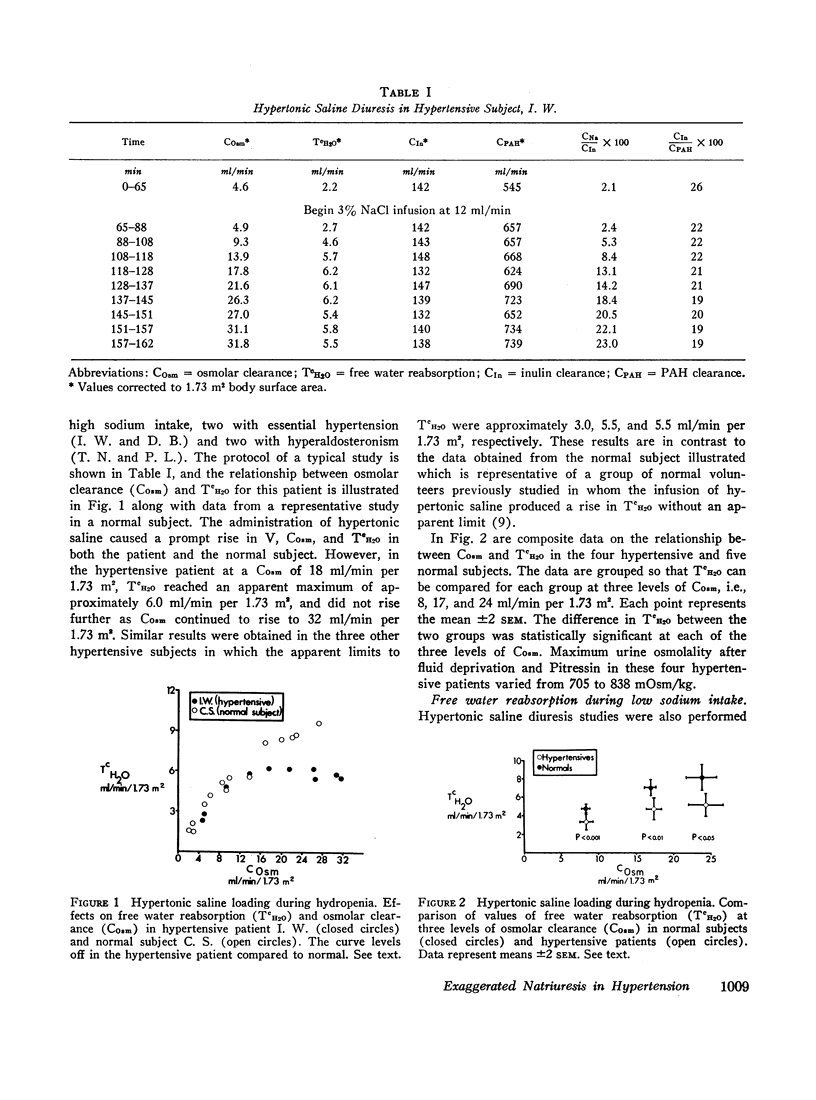
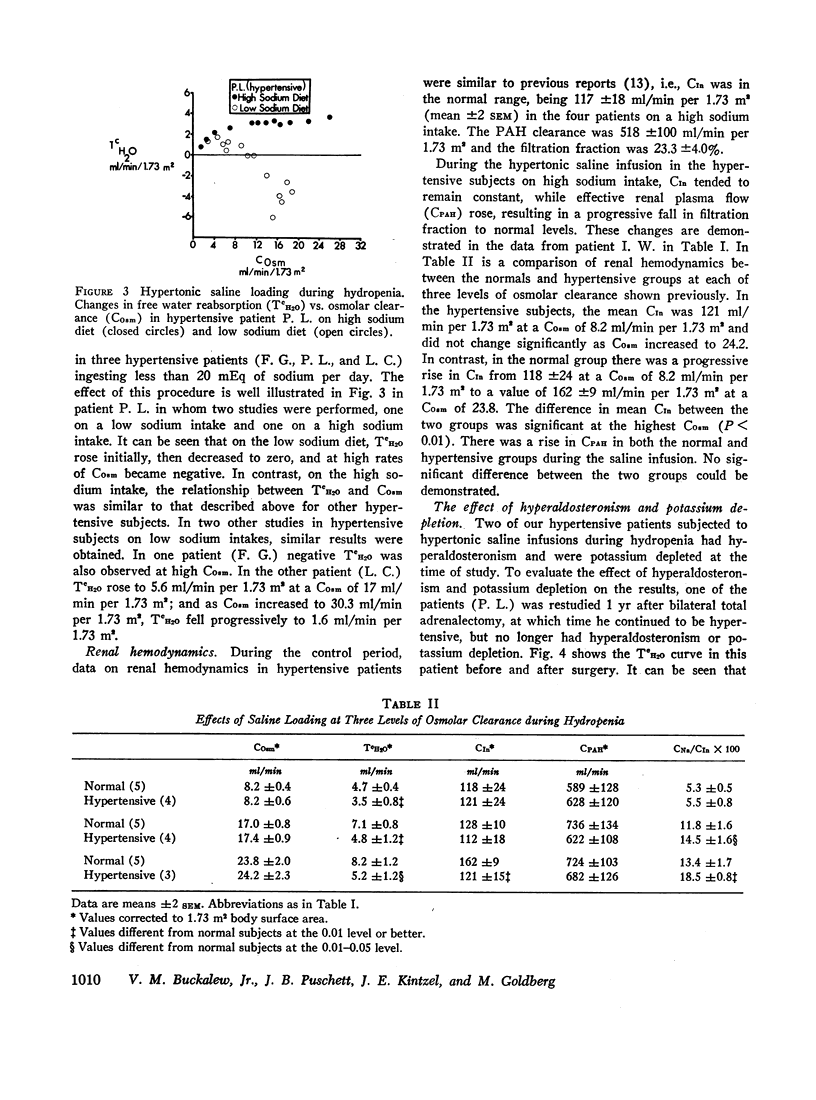
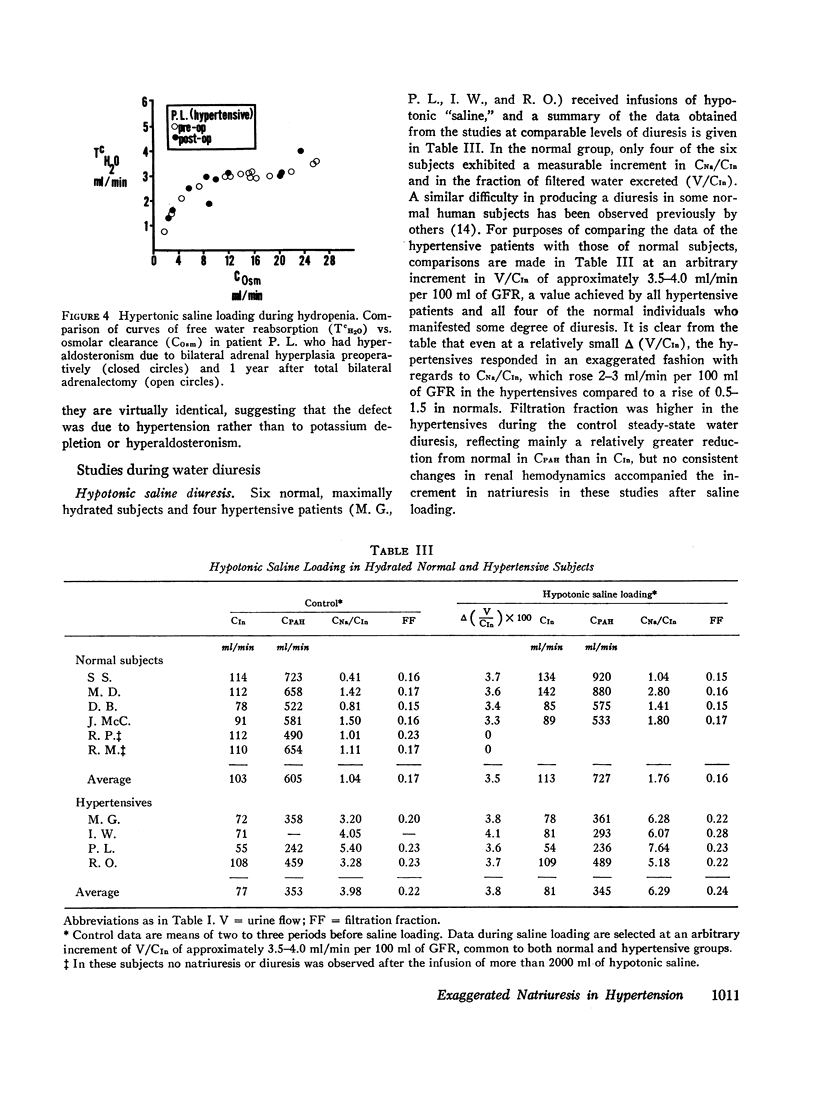

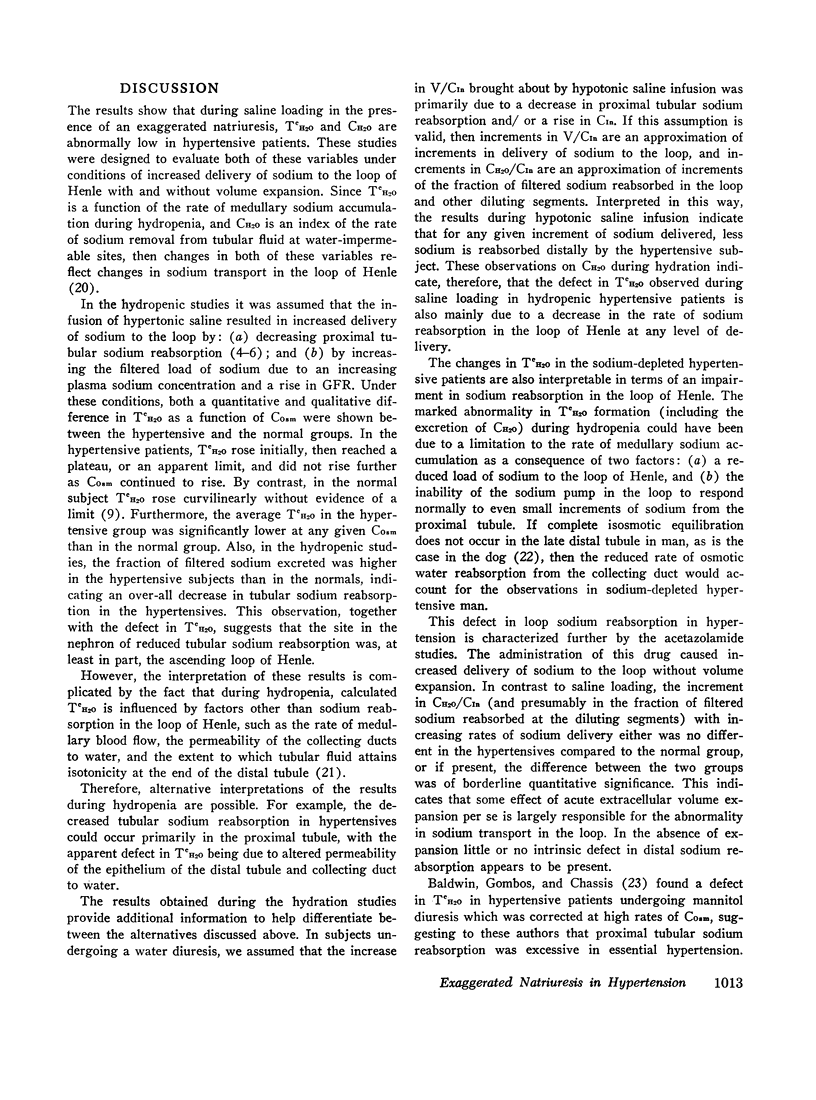
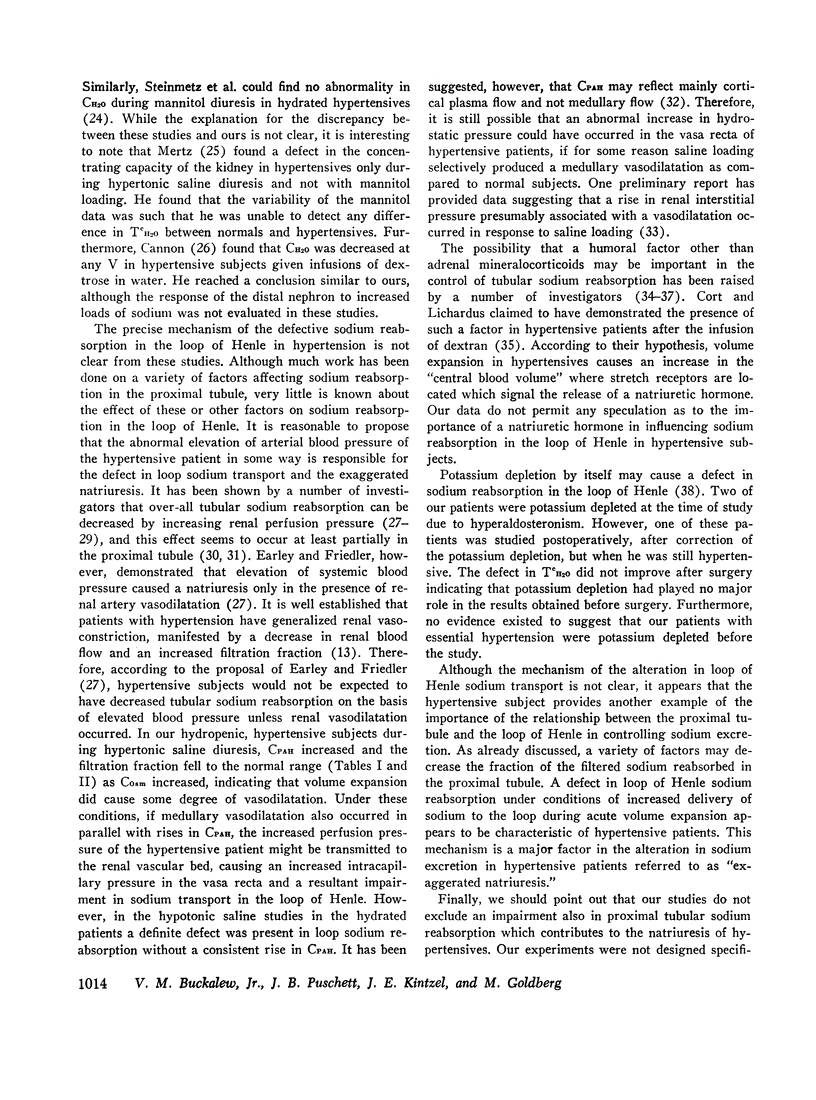
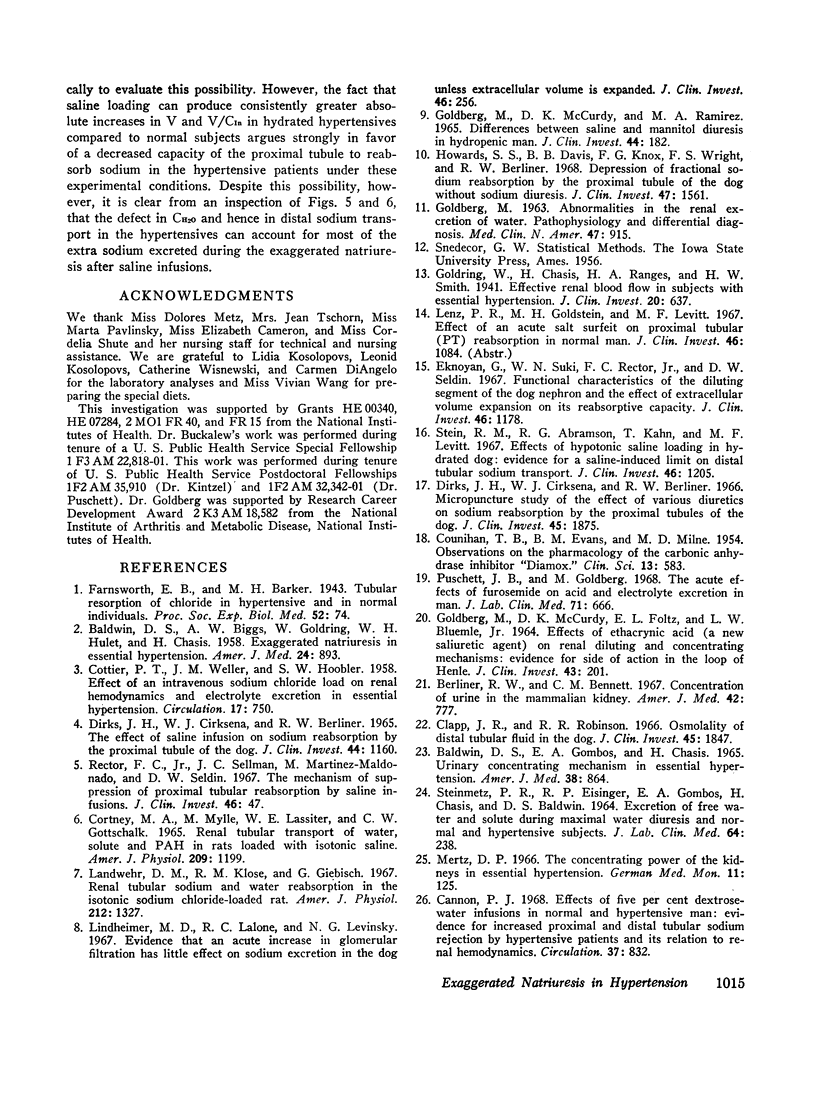

Selected References
These references are in PubMed. This may not be the complete list of references from this article.
- BALDWIN D. S., BIGGS A. W., GOLDRING W., HULET W. H., CHASIS H. Exaggerated natriuresis in essential hypertension. Am J Med. 1958 Jun;24(6):893–902. doi: 10.1016/0002-9343(58)90342-5. [DOI] [PubMed] [Google Scholar]
- BALDWIN D. S., GOMBOS E. A., CHASIS H. URINARY CONCENTRATING MECHANISM IN ESSENTIAL HYPERTENSION. Am J Med. 1965 Jun;38:864–872. doi: 10.1016/0002-9343(65)90005-7. [DOI] [PubMed] [Google Scholar]
- Berliner R. W., Bennett C. M. Concentration of urine in the mammalian kidney. Am J Med. 1967 May;42(5):777–789. doi: 10.1016/0002-9343(67)90095-2. [DOI] [PubMed] [Google Scholar]
- Buckalew V. M., Jr, Ramirez M. A., Goldberg M. Free water reabsorption during solute diuresis in normal and potassium-depleted rats. Am J Physiol. 1967 Feb;212(2):381–386. doi: 10.1152/ajplegacy.1967.212.2.381. [DOI] [PubMed] [Google Scholar]
- COTTIER P. T., WELLER J. M., HOOBLER S. W. Effect of an intravenous sodium chloride load on renal hemodynamics and electrolyte excretion in essential hypertension. Circulation. 1958 Apr;17(4 Pt 2):750–760. doi: 10.1161/01.cir.17.4.750. [DOI] [PubMed] [Google Scholar]
- COUNIHAN T. B., EVANS B. M., MILNE M. D. Observations on the pharmacology of the carbonic anhydrase inhibitor diamox. Clin Sci. 1954 Nov;13(4):583–598. [PubMed] [Google Scholar]
- Cannon P. J. Effects of five per cent dextros-water infusions in normal and hypertensive man. Evidence for increased proximal and distal tubular sodium rejection by hypertensive patients and its relation to renal hemodynamics. Circulation. 1968 May;37(5):832–846. doi: 10.1161/01.cir.37.5.832. [DOI] [PubMed] [Google Scholar]
- Clapp J. R., Robinson R. R. Osmolality of distal tubular fluid in the dog. J Clin Invest. 1966 Dec;45(12):1847–1853. doi: 10.1172/JCI105488. [DOI] [PMC free article] [PubMed] [Google Scholar]
- Cortney M. A., Mylle M., Lassiter W. E., Gottschalk C. W. Renal tubular transport of water, solute, and PAH in rats loaded with isotonic saline. Am J Physiol. 1965 Dec;209(6):1199–1205. doi: 10.1152/ajplegacy.1965.209.6.1199. [DOI] [PubMed] [Google Scholar]
- DIRKS J. H., CIRKSENA W. J., BERLINER R. W. THE EFFECTS OF SALINE INFUSION ON SODIUM REABSORPTION BY THE PROXIMAL TUBULE OF THE DOG. J Clin Invest. 1965 Jul;44:1160–1170. doi: 10.1172/JCI105223. [DOI] [PMC free article] [PubMed] [Google Scholar]
- Davis J. O., Johnston C. I., Howards S. S., Wright F. S. Humoral factors in the regulation of renal sodium excretion. Fed Proc. 1967 Jan-Feb;26(1):60–69. [PubMed] [Google Scholar]
- Dirks J. H., Cirksena W. J., Berliner R. W. Micropuncture study of the effect of various diuretics on sodium reabsorption by the proximal tubules of the dog. J Clin Invest. 1966 Dec;45(12):1875–1885. doi: 10.1172/JCI105492. [DOI] [PMC free article] [PubMed] [Google Scholar]
- Earley L. E., Friedler R. M. The effects of combined renal vasodilatation and pressor agents on renal hemodynamics and the tubular reabsorption of sodium. J Clin Invest. 1966 Apr;45(4):542–551. doi: 10.1172/JCI105368. [DOI] [PMC free article] [PubMed] [Google Scholar]
- Earley L. E., Martino J. A., Friedler R. M. Factors affecting sodium reabsorption by the proximal tubule as determined during blockade of distal sodium reabsorption. J Clin Invest. 1966 Nov;45(11):1668–1684. doi: 10.1172/JCI105474. [DOI] [PMC free article] [PubMed] [Google Scholar]
- Eknoyan G., Suki W. N., Rector F. C., Jr, Seldin D. W. Functional characteristics of the diluting segment of the dog nephron and the effect of extracellular volume expansion on its reabsorptive capacity. J Clin Invest. 1967 Jul;46(7):1178–1188. doi: 10.1172/JCI105611. [DOI] [PMC free article] [PubMed] [Google Scholar]
- GOLDBERG M. Abnormalities in the renal excretion of water. Pathophysiology and differential diagnosis. Med Clin North Am. 1963 Jul;47:915–933. doi: 10.1016/s0025-7125(16)33550-7. [DOI] [PubMed] [Google Scholar]
- GOLDBERG M., MCCURDY D. K., FOLTZ E. L., BLUEMLE L. W., Jr EFFECTS OF ETHACRYNIC ACID (A NEW SALURETIC AGENT) ON RENAL DILUTING AND CONCENTRATING MECHANISMS: EVIDENCE FOR SITE OF ACTION IN THE LOOP OF HENLE. J Clin Invest. 1964 Feb;43:201–216. doi: 10.1172/JCI104905. [DOI] [PMC free article] [PubMed] [Google Scholar]
- GOLDBERG M., MCCURDY D. K., RAMIREZ M. A. DIFFERENCES BETWEEN SALINE AND MANNITOL DIURESIS IN HYDROPENIC MAN. J Clin Invest. 1965 Feb;44:182–192. doi: 10.1172/JCI105133. [DOI] [PMC free article] [PubMed] [Google Scholar]
- Goldring W., Chasis H., Ranges H. A., Smith H. W. EFFECTIVE RENAL BLOOD FLOW IN SUBJECTS WITH ESSENTIAL HYPERTENSION. J Clin Invest. 1941 Nov;20(6):637–653. doi: 10.1172/JCI101257. [DOI] [PMC free article] [PubMed] [Google Scholar]
- Howards S. S., Davis B. B., Knox F. G., Wright F. S., Berliner R. W. Depression of fractional sodium reabsorption by the proximal tubule of the dog without sodium diuresis. J Clin Invest. 1968 Jul;47(7):1561–1572. doi: 10.1172/JCI105848. [DOI] [PMC free article] [PubMed] [Google Scholar]
- Landwehr D. M., Klose R. M., Giebisch G. Renal tubular sodium and water reabsorption in the isotonic sodium chloride-loaded rat. Am J Physiol. 1967 Jun;212(6):1327–1333. doi: 10.1152/ajplegacy.1967.212.6.1327. [DOI] [PubMed] [Google Scholar]
- Lindheimer M. D., Lalone R. C., Levinsky N. G. Evidence that an acute increase in glomerular filtration has little effect on sodium excretion in the dog unless extracellular volume is expanded. J Clin Invest. 1967 Feb;46(2):256–265. doi: 10.1172/JCI105528. [DOI] [PMC free article] [PubMed] [Google Scholar]
- MCDONALD S. J., DE WARDENER H. E. THE RELATIONSHIP BETWEEN THE RENAL ARTERIAL PERFUSION PRESSURE AND THE INCREASE IN SODIUM EXCRETION WHICH OCCURS DURING AN INFUSION OF SALINE. Nephron. 1965;2:1–14. doi: 10.1159/000179370. [DOI] [PubMed] [Google Scholar]
- MILLS I. H., DE WARDENER H. E., HAYTER C. J., CLAPHAM W. F. Studies on the afferent mechanism of the sodium chloride diuresis which follows intravenous saline in the dog. Clin Sci. 1961 Oct;21:259–264. [PubMed] [Google Scholar]
- Mertz D. P. The concentrating power of the kidneys in essential hypertension. Ger Med Mon. 1966 Apr;11(4):125–130. [PubMed] [Google Scholar]
- Puschett J. B., Goldberg M. The acute effects of furosemide on acid and electrolyte excretion in man. J Lab Clin Med. 1968 Apr;71(4):666–677. [PubMed] [Google Scholar]
- REUBI F. Objections à la théorie de la séparation intrarénale des hématies et du plasma (Pappenheimer). Helv Med Acta. 1958 Oct;25(4):516–523. [PubMed] [Google Scholar]
- Rector F. C., Jr, Martinez-Maldonado M., Kurtzman N. A., Sellman J. C., Oerther F., Seldin D. W. Demonstration of a hormonal inhibitor of proximal tubular reabsorption during expansion of extracellular volume with isotonic saline. J Clin Invest. 1968 Apr;47(4):761–773. doi: 10.1172/JCI105771. [DOI] [PMC free article] [PubMed] [Google Scholar]
- Rector F. C., Jr, Sellman J. C., Martinez-Maldonado M., Seldin D. W. The mechanism of suppression of proximal tubular reabsorption by saline infusions. J Clin Invest. 1967 Jan;46(1):47–56. doi: 10.1172/JCI105510. [DOI] [PMC free article] [PubMed] [Google Scholar]
- SELKURT E. E., WOMACK I., DAILEY W. N. MECHANISM OF NATRIURESIS AND DIURESIS DURING ELEVATED RENAL ARTERIAL PRESSURE. Am J Physiol. 1965 Jul;209:95–99. doi: 10.1152/ajplegacy.1965.209.1.95. [DOI] [PubMed] [Google Scholar]
- STEINMETZ P. R., EISINGER R. P., GOMBOS E. A., CHASIS H., BALDWIN D. S. EXCRETION OF FREE WATER AND SOLUTE DURING MAXIMAL WATER DIURESIS IN NORMAL AND HYPERTENSIVE SUBJECTS. J Lab Clin Med. 1964 Aug;64:238–256. [PubMed] [Google Scholar]
- Stein R. M., Abramson R. G., Kahn T., Levitt M. F. Effects of hypotonic saline loading in hydrated dog: evidence for a saline-induced limit on distal tubular sodium transport. J Clin Invest. 1967 Jul;46(7):1205–1214. doi: 10.1172/JCI105614. [DOI] [PMC free article] [PubMed] [Google Scholar]


